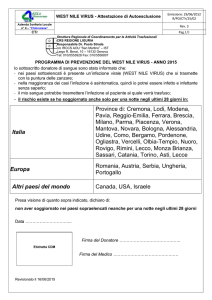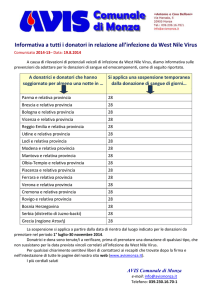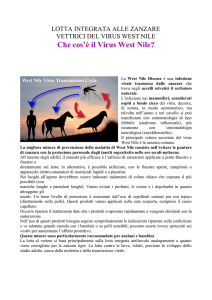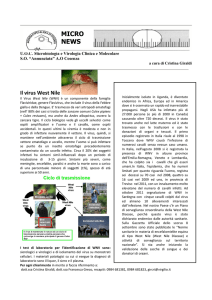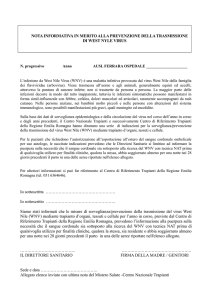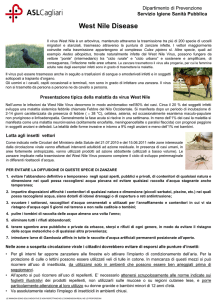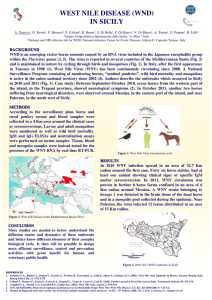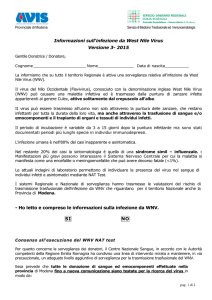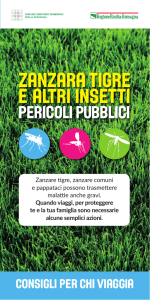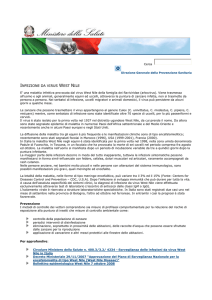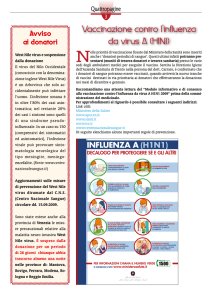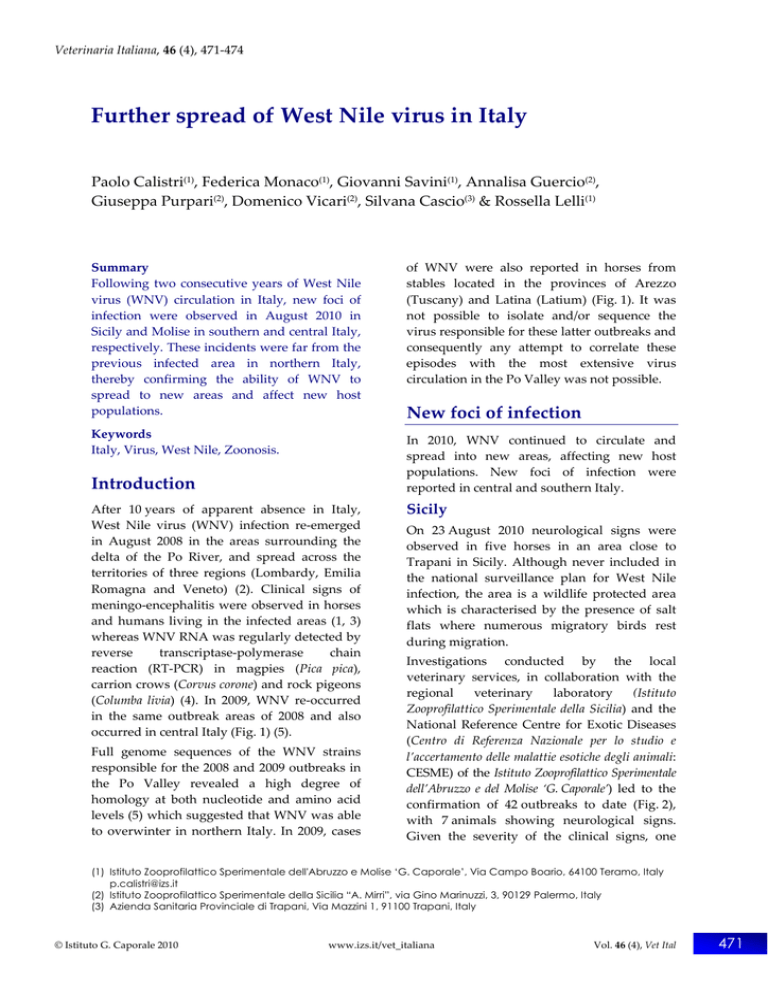
Veterinaria Italiana, 46 (4), 471‐474 Further spread of West Nile virus in Italy Paolo Calistri(1), Federica Monaco(1), Giovanni Savini(1), Annalisa Guercio(2), Giuseppa Purpari(2), Domenico Vicari(2), Silvana Cascio(3) & Rossella Lelli(1) Summary Following two consecutive years of West Nile virus (WNV) circulation in Italy, new foci of infection were observed in August 2010 in Sicily and Molise in southern and central Italy, respectively. These incidents were far from the previous infected area in northern Italy, thereby confirming the ability of WNV to spread to new areas and affect new host populations. Keywords Italy, Virus, West Nile, Zoonosis. of WNV were also reported in horses from stables located in the provinces of Arezzo (Tuscany) and Latina (Latium) (Fig. 1). It was not possible to isolate and/or sequence the virus responsible for these latter outbreaks and consequently any attempt to correlate these episodes with the most extensive virus circulation in the Po Valley was not possible. New foci of infection In 2010, WNV continued to circulate and spread into new areas, affecting new host populations. New foci of infection were reported in central and southern Italy. Introduction After 10 years of apparent absence in Italy, West Nile virus (WNV) infection re‐emerged in August 2008 in the areas surrounding the delta of the Po River, and spread across the territories of three regions (Lombardy, Emilia Romagna and Veneto) (2). Clinical signs of meningo‐encephalitis were observed in horses and humans living in the infected areas (1, 3) whereas WNV RNA was regularly detected by reverse transcriptase‐polymerase chain reaction (RT‐PCR) in magpies (Pica pica), carrion crows (Corvus corone) and rock pigeons (Columba livia) (4). In 2009, WNV re‐occurred in the same outbreak areas of 2008 and also occurred in central Italy (Fig. 1) (5). Full genome sequences of the WNV strains responsible for the 2008 and 2009 outbreaks in the Po Valley revealed a high degree of homology at both nucleotide and amino acid levels (5) which suggested that WNV was able to overwinter in northern Italy. In 2009, cases Sicily On 23 August 2010 neurological signs were observed in five horses in an area close to Trapani in Sicily. Although never included in the national surveillance plan for West Nile infection, the area is a wildlife protected area which is characterised by the presence of salt flats where numerous migratory birds rest during migration. Investigations conducted by the local veterinary services, in collaboration with the regional veterinary laboratory (Istituto Zooprofilattico Sperimentale della Sicilia) and the National Reference Centre for Exotic Diseases (Centro di Referenza Nazionale per lo studio e l’accertamento delle malattie esotiche degli animali: CESME) of the Istituto Zooprofilattico Sperimentale dell’Abruzzo e del Molise ‘G. Caporale’) led to the confirmation of 42 outbreaks to date (Fig. 2), with 7 animals showing neurological signs. Given the severity of the clinical signs, one (1) Istituto Zooprofilattico Sperimentale dell'Abruzzo e Molise ‘G. Caporale’, Via Campo Boario, 64100 Teramo, Italy
[email protected]
(2) Istituto Zooprofilattico Sperimentale della Sicilia “A. Mirri”, via Gino Marinuzzi, 3, 90129 Palermo, Italy
(3) Azienda Sanitaria Provinciale di Trapani, Via Mazzini 1, 91100 Trapani, Italy
© Istituto G. Caporale 2010 www.izs.it/vet_italiana Vol. 46 (4), Vet Ital 471 Further spread of West Nile virus in Italy Paolo Calistri, Federica Monaco, Giovanni Savini, Annalisa Guercio, Giuseppa Purpari, Domenico Vicari, Silvana Cascio & Rossella Lelli N
Arezzo
outbreak
2008 epidemic
2009 epidemic
Latina outbreak
0
25 50
100
150
200 km
Figure 1
Areas of Italy affected by West Nile virus infection in 2008 and 2009
N
2010 epidemic
0
15
30
60
90
120 km
Figure 2
Areas affected by West Nile virus infection in Sicily in 2010
horse had to be euthanised. A retrospective serological analysis of sera collected from dogs in the Trapani area proved that the infection was present in the area at least since the end of January. No human case has been reported to date. Further surveillance activities are ongoing to better define the area in which the virus is circulating. Molise On 31 August 2010, a sentinel horse in the Campobasso Province seroconverted to WNV (Fig. 3). The animal which tested negative on 472
Vol. 46 (4), Vet Ital the 29 May revealed IgM and neutralising antibodies (titre 1:80). To date, 7 outbreaks have been detected, based on serological tests. The area was included in those covered by specific surveillance activities since 2001 and in November 2009, positive serological findings were obtained in two chickens on one rural farm. Subsequent WNV serological investigations in the 4 km radius area around the chicken farm detected IgG antibodies in 5 horses belonging to three stables. Clinical signs have not been observed to date, either in horses or in humans. Local veterinary services www.izs.it/vet_italiana © Istituto G. Caporale 2010 Paolo Calistri, Federica Monaco, Giovanni Savini, Annalisa Guercio, Giuseppa Purpari, , Domenico Vicari, Silvana Cascio & Rossella Lelli Further spread of West Nile virus in Italy are performing additional investigations in all horse stables in an area of 4 km around the outbreak. In 2010, late summer cases of West Nile disease were reported in Europe and across the Mediterranean Basin, in Greece (8), Morocco (9), Spain (10), Turkey (6) and in Russia (7). Discussion It is not currently possible to say whether or not all these 2010 WND episodes that have occurred across Europe and the Mediterranean Basin are correlated. In the last decade, an increase in the notification of episodes of West Nile infection has been observed in Europe and in the Mediterranean Basin. This increase could be linked to greater efforts of veterinary and public health authorities to detect vector‐borne diseases. However, the continued detection of foci of WNV throughout Europe and the Mediterranean Basin which represents a constant threat for public health, might also imply the presence of endemic areas in these regions. Conclusion There is a need for both public health authorities and researchers of the countries involved to work closely together to identify the principal epidemiological mechanisms behind the scattered foci of WND infection currently being observed. N
2009 epidemic
2010 epidemic
0
15
30
60
90
120 km
Figure 3
Areas affected by West Nile virus infection in Arezzo and Latina (2009)
and Campobasso (2010) Provinces
References 1.
Calistri P., Giovannini A., Hubalek Z., Ionescu A., Monaco F., Savini G. & Lelli R. 2010. Epidemiology of
West Nile in Europe and in the Mediterranean Basin. Open Virol J, 4, 29-37.
2.
Calistri P., Giovannini A., Savini G., Monaco F., Bonfanti L., Ceolin C., Terregino C., Tamba M.,
Cordioli P. & Lelli R. 2010. West Nile virus transmission in 2008 in north-eastern Italy. Zoonoses Public
Health, 57 (3), 211-219.
3.
Gobbi F., Napoletano G., Piovesan C., Russo F., Angheben A., Rossanese A., Cattelan A.M., Gallo L.,
Valsecchi M., Piazza A., Venturi G. & Bisoffi Z. 2009. Where is West Nile fever? Lessons learnt from
© Istituto G. Caporale 2010 www.izs.it/vet_italiana Vol. 46 (4), Vet Ital 473 Further spread of West Nile virus in Italy Paolo Calistri, Federica Monaco, Giovanni Savini, Annalisa Guercio, Giuseppa Purpari, Domenico Vicari, Silvana Cascio & Rossella Lelli recent human cases in northern Italy. Euro Surveill, 14 (10), pii: 19143
surveillance.org/ViewArticle.aspx?ArticleId=19143 accessed on 7 November 2010).
(www.euro
4.
Monaco F., Lelli R., Teodori L., Pinoni C., Di Gennaro A.P., Polci A., Calistri P. & Savini G. 2009.
Re-emergence of West Nile virus in Italy. Zoonoses Public Health, Jul 23 (Epub ahead of print)
doi:10.1111/j.1863-2378.2009.01245.x.
5.
Monaco F., Savini G., Calistri P., Polci A., Pinoni C., Bruno R. & Lelli R. 2011. West Nile disease
epidemic in Italy. First evidence of overwintering in Europe? Res Vet Sci (in press).
6.
ProMED-mail 2010. Encephalitis – Turkey (Manisa) West Nile virus suspected, request for information.
ProMED mail, Archive No. 20100826.3014, 26 August (www.promedmail.org/pls/otn/f?p=2400:
1001:80787::no::f2400_p1001_back_page,f2400_p1001_pub_mail_id:1010,84433
accessed
on
7 November 2010).
7.
ProMED-mail 2010. West Nile virus, Russia: (Volgograd). ProMED mail, Archive No. 20100824.2979,
24 August (www.promedmail.org/pls/otn/f?p=2400:1202:80787::no::f2400_p1202_check_display,f24
00_p1202_pub_mail_id:x,84393 accessed on 7 November 2010).
8.
World Animal Health Information Disease Database (WAHID) 2010. West Nile fever, Greece. World
Organisation for Animal Health, Paris (www.oie.int/wahis/public.php?page=single_report&pop=
1&reportid=9642 accessed on 7 November 2010).
9.
World Animal Health Information Disease Database (WAHID) 2010. West Nile fever, Morocco. World
Organisation for Animal Health, Paris (www.oie.int/wahis/public.php?page=single_report&pop
=1&reportid=9615 accessed on 7 November 2010).
10. World Animal Health Information Disease Database (WAHID) 2010. West Nile fever, Spain. World
Organisation for Animal Health, Paris (www.oie.int/wahis/public.php?page=single_report&
pop=1&reportid=9695 accessed on 7 November 2010).
474
Vol. 46 (4), Vet Ital www.izs.it/vet_italiana © Istituto G. Caporale 2010

